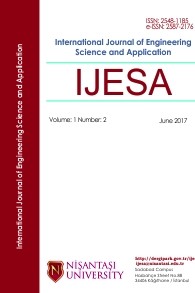Enhancement of Long Term Evolution Advanced Performance using Distributed Antenna Systems
Enhancement of Long Term Evolution Advanced Performance using Distributed Antenna Systems
___
- [1] S. Jaswal, A. Kumar, and N. Kumari, “Development of wireless communication networks: From 1G to 5G”, International Journal of Engineering and Computer Science, Vol. 3, No. 5, pp. 6053-6056, 2014.
- [2] J. Agrqwal, R. Patel, P. Mor, P. Dubey, and J.M. Keller, “Evolution of mobile communication network: From 1G to 4G”, International Journal of Multidisciplinary and Current Research, Vol. 3, No. Nov. /Dec., pp. 1100-1103, 2015.
- [3] I.F. Akyildiz, D.M. Gutierrz-Estevez, R. Balakrishnan, and E. Chavarria-Reyes, “LTE-Advanced and the evolution to beyond 4G (B4G) systems”, Physical Communication, Vol. 10, pp. 31-60, 2014.
- [4] D. Astely, E. Dahlman, A. Furuskar, Y. Jading, M. Lindstrom, and S. Parkvall, “LTE: The evolution of mobile broadband”, IEEE Communications Magazine, Vol. 47, No. 4, pp. 44-51, 2009.
- [5] M. Prasad, R. Manoharan, and P. Suriya, “An effective resource allocation scheme in relay enhanced LTE-A”, Proceedings of International Conference in Communication, Network, and Computing, pp. 173-178, 2013.
- [6] S. Kanchi, S. Sandilya, S.D. Bhosale, A. Pitkar, and M. Gondhalekar, “Overview of LTE-A Technology”, International Journal of Scientific and Technology Research, Vol. 2, No. 11, pp. 138-143, 2013.
- [7] Z. Liu, T. Sørensen, J. Wigard, J. Petri, T. Kolding, and P. Mogenesen, “A site-specific study of in-building wireless solutions”, 71st IEEE Vehicular Technology Conference, Taipei, Taiwan, pp. 1-5, 16-19 May 2010.
- [8] R. Atawia, M. Ashour, T.E. Shabrawy, and H. Hammed, “Optimized transmitted antenna power indoor planning using distributed antenna systems”, 9th IEEE Wireless Communications and Mobile Computing Conference, Cagliari, Sardinia-Italy, pp. 993-1000, 1-5 July 2013.
- [9] V. Chandrasekhar, J. Andrews, and A. Gatherer, “Femtocell networks: A survey”, IEEE Communications Magazine, Vol. 46, No. 9, pp. 59-67.
- [10] A.A.M. Saleh, A.J. Rustako, and R.S. Roman, “distributed antennas for indoor radio communications”, IEEE Transaction on Wireless Communication, Vol. 35, No. 12, pp. 1245-1251.
- [11] E. Park, S.-R. Lee, and I. Lee, “Antenna placement optimization for distributed antenna systems”, IEEE Transaction on Wireless Communication, Vol. 11, No. 7, pp. 2468-2477.
- [12] M. Behjati, R. Nordin, and M. Ismail, “Investigation of rate-loss due to limited feedback LTE-Advanced distributed antenna systems”, 2nd International Symposium on Telecommunication Technologies, Langkawi, Malaysia, pp. 6-10, 24-26 November 2014.
- [13] R.W. Heath, T. Wu, Y.H. Kwon, and A.C. Song, “Multiuser MIMO in distributed antenna systems with out-of-cell interface”, IEEE Transaction on Signal Processing, Vol. 59, No. 10, pp. 4885-4899.
- [14] R.W. Heath, S.W. Peters, Y. Wang, and J. Zhang, “A current perspective on distributed antenna systems for the downlink of cellular systems”, IEEE Communications Magazine, Vol. 51, No. 4, pp. 161-167.
- [15] W. Choi, and J.G. Andrews, “Downlink performance and capacity of distributed antenna systems in a multicell environment”, IEEE Transaction on Wireless Communication, Vol. 6, No. 1, pp. 69-73.
- [16] O. Stanze, and A. Weber, “Heterogeneous networks with LTE-Advanced Technologies”, Bell Labs Technical Journal, Vol. 18, No. 1, pp. 41-58.
- [17] C.-H. Lee, S.-H. Lee, K.-M. Oh, J.S. J.-H. Kim, “Mobile small cells for further enhanced 5G heterogeneous networks”, Electronics and Telecommunication Research Institute Journal, Vol. 37, No. 5, pp. 856-866.
- [18] S.N.S. Kshatriya, S. Kaimaletttu, SW.R. Yerrapareddy, K. Milleth, and N. Akhtar, “On interface management based on subframe blanking in heterogeneous LTE networks”, 5th IEEE International Conference on Communication Systems and Networks, Bangalore, India, pp. 1-7, 7-10 January 2013.
- [19] A. Ghosh, R. Ratasuk, B. Mondal, N. Mangalvedhe, and T. Thomas, “LTE-Advanced: Next generation wireless broadband technology”, IEEE Wireless Communications, Vol. 17, No. 3, pp. 10-22.
- [20] D. Lopez-Perez, I. Guvene, G. de la Roche, M. Kountouris, T.QS. Quek, and J. Zhang, “Enhanced inter-cell interference coordination challenges in heterogeneous networks”, IEEE Wireless Communications, Vol. 18, No. 3, pp. 22-30.
- [21] N. Lux, X. Zhu, F. Yang, and Q. Bi, “Downlink MIMO performance evaluation for LTE/LTE-A indoor distributed antenna systems”, 1st IEEE International Conference on Communications in China: Wireless Networking and Applications, Beijing, China pp. 781-785, 15-18 August 2012.
- [22] A. Attar, H. Li, and V.C.M. Leung, “Applications of fibre-connected distributed antenna systems in broadband wireless access”, 1st IEEE International Conference on Computing and Communications, Maui, Hl, USA, pp. 623-627, 30 January- 2 February 2012.
- [23] L-Com, “What is a distributed antenna systems (DAS)?”, Global connectivity. Online [Available]: http:www/l-com.com/what-is-a-distributed-antenna-system-das. Retrieved 23, 2017.
- [24] M. Kurras, K. Borner, L. Thiele, and T. Haustein, “Achievable system performance gains using distributed antenna deployments”, 23rd Annual IEEE International Symposium on Personal, Indoor and Mobile Radio Communications, Sydney, NSW, Australia, pp. 143-148, 9-12 September 2012.
- [25] P. Kyosti, J. Meinila, X. Zhao, T. Jamsa, C. Schneider, M. Narandzic, M. Milojevic, A. Hong, J. Ylitalo, V.-M. Holappa, M. Alatossava, R. Bultitude, Y. de Jong, and T. Rautianinen, “1ST -4-027756 WINNER II D1.1.1 V1.1 WINNER II Channel Models”, pp. 1-82. Online [Available]: http://projects.celtic-initiative.org/winner+/WINNER2-Deliverables/D1.12v.1.pdf. Retrieved 23, 2017.
- [26] L. Chen, and D. Yuan, Mathematical modelling for optimal design of in-building distributed antenna systems”, Computer Networks, Vol. 57, No. 17, pp. 3428-3445
- ISSN: 2548-1185
- Başlangıç: 2016
- Yayıncı: Nişantaşı Üniversitesi
Bachar RAHİMA, Golea AMAR, Benchouia M-T
A Hybrid Genetic-Ant Colony Algorithm for Travelling Salesman Problem
Deniz AKDUR, Ebru ÖZPOLAT, Tuna BAŞIBÜYÜK
Programming Encryption Algorithms with Steganography
Exergetic analysis and comparative study of a roughened solar air heater using MATLAB
Enhancement of Long Term Evolution Advanced Performance using Distributed Antenna Systems
